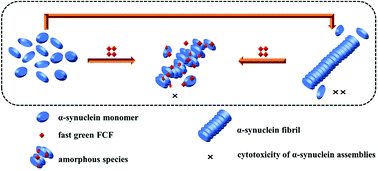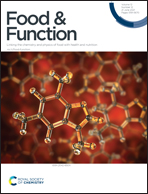The food additive fast green FCF inhibits α-synuclein aggregation, disassembles mature fibrils and protects against amyloid-induced neurotoxicity†
Abstract
α-Synuclein (α-syn) aggregates into cytotoxic amyloid fibrils, which are recognized as the defining neuropathological feature of Parkinson's disease (PD). Therefore, inhibiting α-syn fibrillogenesis and disrupting the preformed fibrils are both considered attractive strategies to cure PD. We discovered that a safe food additive, fast green FCF, is capable of inhibiting α-synuclein fibrillogenesis and reducing the related cytotoxicity. Thioflavin T fluorescence assays demonstrated that fast green FCF could inhibit the fibrillogenesis α-synuclein. In the presence of 100 μM fast green FCF, amorphous aggregates were formed and observed by atomic force microscopy. Toxicity assays in cell cultures revealed that fast green FCF significantly reduced the cytotoxicity of α-syn. Molecular dynamics simulations revealed the potential mechanism of the interactions between fast green FCF and α-synuclein. Fast green FCF greatly disrupted the α-synuclein pentamer and reduced the β-sheet content by reducing both nonpolar and polar interactions. Furthermore, two binding sites were identified, named region I (Y39-K45) and region II (H50-Q62). Our data reveal that electrostatic interactions, hydrogen bonds, and π–π interactions synergistically contribute to the binding of fast green FCF to the α-synuclein pentamer. These results indicate that fast green FCF is a candidate prototype for the development of drugs against the aggregation of amyloid fibrils in PD.



 Please wait while we load your content...
Please wait while we load your content...